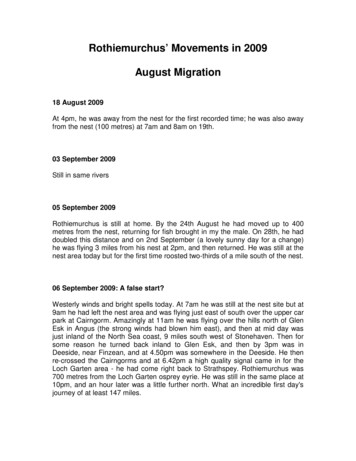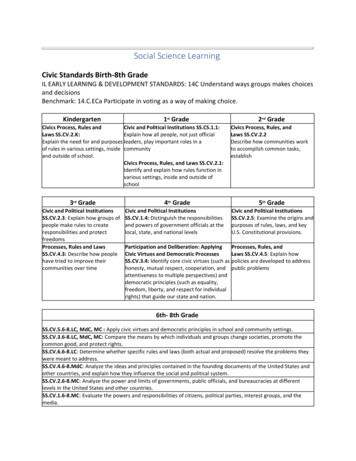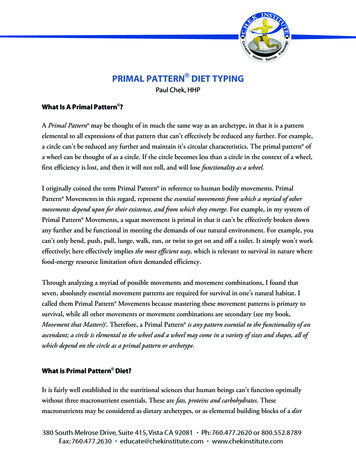
Transcription
Rothiemurchus’ Movements in 2009August Migration18 August 2009At 4pm, he was away from the nest for the first recorded time; he was also awayfrom the nest (100 metres) at 7am and 8am on 19th.03 September 2009Still in same rivers05 September 2009Rothiemurchus is still at home. By the 24th August he had moved up to 400metres from the nest, returning for fish brought in my the male. On 28th, he haddoubled this distance and on 2nd September (a lovely sunny day for a change)he was flying 3 miles from his nest at 2pm, and then returned. He was still at thenest area today but for the first time roosted two-thirds of a mile south of the nest.06 September 2009: A false start?Westerly winds and bright spells today. At 7am he was still at the nest site but at9am he had left the nest area and was flying just east of south over the upper carpark at Cairngorm. Amazingly at 11am he was flying over the hills north of GlenEsk in Angus (the strong winds had blown him east), and then at mid day wasjust inland of the North Sea coast, 9 miles south west of Stonehaven. Then forsome reason he turned back inland to Glen Esk, and then by 3pm was inDeeside, near Finzean, and at 4.50pm was somewhere in the Deeside. He thenre-crossed the Cairngorms and at 6.42pm a high quality signal came in for theLoch Garten area - he had come right back to Strathspey. Rothiemurchus was700 metres from the Loch Garten osprey eyrie. He was still in the same place at10pm, and an hour later was a little further north. What an incredible first day'sjourney of at least 147 miles.
07 September 2009: Off South to EnglandThe first good signal was at 11am, when Rothiemurchus was 77 miles down theroad, over the hills just west of Dundee. He crossed the Tay estuary and wasflying SSW at 26 km/h 870 metres above Cupar in Fife at midday. He then flewout over the Firth of Forth and came ashore near Tantallon Castle, east of NorthBerwick. At 2pm he was flying south just north of Chirnside in the Borders. Soonhe crossed the English border and at 3pm was flying SSE at 50km/h just north ofWooler. He continued south past Rothbury and by 5pm had stopped by a smalllake, just south of Wingates, and 7 miles north west of Morpeth. His day's journeywas just an excellent migration in the right direction and covered 161 miles.
Migration to Northumberland08 September 2009: Stuck in NorthumberlandThe first signals show that Rothiemurchus left his roost and flew south east andat 11am was just offshore of Newbiggin over the North Sea, flying east at 33km/hat 29 metres above the water (or was he being blown by the westerly winds andrain). Fortunately he turned back and at midday he was perched for severalhours near Ulgam; and then at 2pm was between the A1 and A696 perched in awood at Espley Hall. Not a good day for young ospreys to be migrating and heonly covered just over 20 miles.
09 September 2009: Flying through EnglandHe had left the roost after seven and at 8am was flying SSW that 25m/h west ofBelsay; at midday Rothiemurchus was flying SSW at 55km/h at 789 metresaltitude 5 miles WNW of Harrowgate. At 4pm he had covered 194 miles and wasjust north of Ismere SW of Stourbridge, near Birmingham. He flew further to thewest, probably because of a north-east wind, and at 8pm he was high up nearLydeard St Lawrence in Somerset. He moved a little to the west and roosted in awood overnight 1 mile NW of the village. He had flown 298 miles during the day.
10 September 2009: Off on a hazardous journeyRed 8T must have set off early, as at 10am he was flying SSW at 64km/h justoffshore from Teignmouth in South Devon, and then left the coast at Salcombe tohead out into the English Channel and the south west approaches. At 11am hewas 7 miles offshore still flying SSW at 82km/h 191 metres over the sea. Atmidday he was 50 miles out to sea and still on the same track. The weatherforecast is that the winds are NE and fresh, with clear visibility. The problem forRothiemurchus is that if he continues on this heading he will miss the westernend of Brittany. Then, unless he changed direction, he would need to travel overthe whole of the Bay of Biscay, and again on this heading and with easterlywinds he could miss the north-west corner of Spain. He is, I'm afraid, on a difficultmigration and I just hope he gets through. More news as soon as the data comesin.
11 September 2009: He’s reached PortugalToday's look at the data shows that Rothiemurchus was ashore by 1900GMTand was in a small wood in a town along the Portuguese coast just north ofEspina, and he was still the same site an hour later. Hope he has a rest ofovernight and then finds somewhere to catch fish.
Roosting site among houses and roads
11 September 2009: Fingers crossed4pm: first few signals just in - the map shows two GPS signals for 2100 and2200hrs GMT last night, which showed that Rothiemurchus had flown 455 miles(732 kms) from South Devon across the Bay of Biscay. Unfortunately, hisheading was going to miss NW Spain, but between the two points he had headedslightly more easterly. By now with continued flight he could have coveredanother 500 miles - putting him west of Portugal. There the wind forecast is NWwith clear skies, so he might be drifted in enough to see the coast.More to come! Later he did start flying to the SE at 0600GMT when thetransmitters restarted for the day - over the next four hourly fixes he was flyingSE or SSE 27-35km/h about 40-47 metres above the sea. Then at 1000 to1200GMT he only traveled 3 kilometres north in 3 hours - was he on a boat orsomething floating in the sea? And then at 1711GMT his next non GPS fix is 143kilometres (88 miles) SE - to a location about 8 miles off Porto, Portugal. Needsome GPS locations to try to work out what is going on - did he rest and then flyon; did he fish and feed while on something floating on the sea, was he on a boat- did he fly on or was he on a boat going to Porto harbour? We should find outwith the next transmissions.New position 1852GMT - Rothiemurchus 5 kilometres off Espinho.
Distance covered so far 1396 kilometres (867 miles) in 36 hours12 September 2009: He survived!There is always a worry after a long and difficult migration that the young ospreyis so exhausted that it cannot continue its journey. But Rothiemurchus hassurvived and has moved on. He stayed in the wood until at least 0900GMT andmade several moves in the trees behind the car scrapyard (I find it incredible withGoogle Earth that you can actually see where one of our ospreys is roosting). At1000GMT he was flying above Santa Maria de Lamas, 8 km to the south east,and travelling to 27km/h at an altitude of 65 metres. An hour later he wastravelling at 26km/h over Cebecais and at midday was perched beside a smallriver in high hills 41 kms from last night roost. This river wound through the hillsand he spent the whole day and down the river, and hopefully there are somefish in it for him to catch and eat. This area is 6 kilometres SE of Arouca. Heroosted the night there on a hillside.
thLocations during 12 and roost13 September 2009Spent the whole day in the hills, and in afternoon moved a short distance SE tohaunt the small river near a village. Roosted in wooded hills that night.
14 September 2009Today was spent along the same valleys, with Rothiemurchus moving a littlenorth in the afternoon, and again roosting in the higher hills above the river.
ththNight roost 14 -15 September16 September 2009Rothiemurchus has continued to spend his time along these mountain rivers moving quite widely. They look good for him catching fish, so hopefully he isbuilding up strength to continue his migration.
Locations during his stay up until this evening18 September 2009He is still wandering the mountains streams looking for fish, and has moved a bitfurther north.
19 September 2009Still in same area but moved back south.22 September 2009Rothiemurchus is still wandering around the rivers NW of Arouca in Portugal.23 September 2009This evening, 1729GMT he is back south on the river near Janarde.24 September 2009He is still working the rivers to the NE of Arouca. Sue Coxon sent me this videolink on Youtube, of the river Rothiemurchus was fishing during his stopover in
atch?v b-xFj5dx5VAtributaryoftheDouro.The video is by a campaign group fighting to save this famously clean trout river,from pollution and development.27 September 2009Rothiemurchus is still living in the mountain rivers - hope he is getting enoughfish to build up strength to move on, or he may winter in Portugal.Last 10 days02 October 2009Still in same general area but moving up and down the main rivers.03 October 2009
Still in same area.Locations East of Arouca12 October 2009He still remains in the same area but moves about quite widely on the rivers tothe east of Arouca. Is he still on a stopover or is he going to winter in Portugal?
thth11 -12 October16 October 2009: Migration restartsAfter 5 weeks in the mountain rivers near Arouca, Rothiemurchus has set ofsouth. He roosted last night in a favourite site above the river and below thevillage Vilariulo; at 0900GMT he was perched further south, and then at1000GMT he was flying south 3.7 kms east of Arouca. An hour later he wasmigrating south through Portugal at 70kms/h and at 569 metres. The weatherwas clear and sunny, with a light NE wind, ideal for migration. At the lasttransmission of the day (1300hrs), Rothiemurchus was flying SW at 74kms/h andwas inland of Figueira da Foz. He continued south and roosted on a wooded hillto the south of Freira, having flown 237 kilometres. A good journey for the firstday after a long rest. Looks like he will travel down the Portugal coast; hope hechanges direction towards southern Spain rather than leave SW Portugal foranother Ocean crossing.Morning flight south
Full day’s flight17 October 2009He had flown 14 km SSW 0700 hours, and then kept flying south passing Sintraan hour later, but at 0900GMT he was perched in wooded hills south or west ofSintra. He flew out to sea over Estoril heading SSE. At 1000GMT he was flyingSSE at 40km/h 207 metres above the sea, he crossed over the peninsula atAzoia, then headed across to the coast and came ashore just north of Sines. Heturned south and flew down the Alentjo Coast, passing over the Ria Mira, inlandof Vila Nova de Milfontes. This is an area I visited some years ago and saw thelast osprey nest site in Portugal. At 1500GMT he was flying SSW at 55km/hinland of Zambujeira, and at 1800GMT a non-GPS signal gave his location as 14km north west of Lagos.
222km18 October 2009: Great flight to MoroccoAt 0700GMT Rothiemurchus was perched 3 kilometres south of the overnightroost. An hour later he was close to the coast flying SSW at 49kms/h and soonflew out over the sea to Africa between Salema and Burgau in South WestPortugal. He then made a textbook crossing of 394 kilometres across the AtlanticOcean to Africa. His track was SSE and for the first 3 hours he kept up aconstant speed of 55kms/h, which dropped to 45 kms/h in the mid 3 hours of theflight, and then increased again to 54km/h as he neared the coast. The weatherwas clear with a very light SW wind. He was fortunate. He crossed the coastsoon after 1600GMT between Mohammedia and Dar-el-Beida, and then turnedSSW going through Morocco. Just after 2 hours later he stopped to roostovernight in farmland east of Berrechild.His long stopover in Portugal had obviously allowed him to get back into goodcondition and today's migration over the ocean demonstrates a strong flyer. Henow has the mountains in Morocco in front of him and then the desert before hecan reach West Africa.
19 October 2009He had set off about 0800GMT, and was migrating SSW at 9am; he continued ina SSW direction until he hit the coast and then turned south - flying at 65km/h at1700GMT. After reaching a headand, SW of Tamanar he flew SE and ESE overthe sea flying at 76km/h 110 metres above the Atlantic Ocean. He flew over thecoast at Taghazout and roosted the night in a valley north of Agadir, in scattteredbushes.
20 October 2009He is migrating strongly down through Morocco on SSW heading, and at1018GMT this morning was 34 kilometres SE of Agadir, by 1600GMT he washeading for Tan-Tan, and already well on for long journey SSW throughMorocco. He was also flying fast with a tail wind; at 1900GMT he was flying S at72 km/h, and an hour later passed east of Smara in West Sahara.Rothiemurchus was still flying strongly south at the last GPS fix at 2200 GMT,and he continued south to complete a day's migration of 625 kilometres beforeroosting in the desert in a few bushes on a high dune, about 65 kilometres fromZemmour.
21 October 2009: On through the desert to MauritaniaAt 9am he was perched in the desert 5 kilometres to the south, and then set offfor another long flight. Again he was attaining high speeds 67 Km/h SSW at1200GMT, and then 80 km/h SSW at 1400GMT, when he was flying at 1398metres - he passed west of some dramatic rock islands in the desert. At1700GMT he was flying SW at 73km/h at 1378 metres just north of the desertroad to Aoussard, and by 2 hours later was perched in the sand dunes. Hemoved at 2100GMT a kilometre further south to roost for the night, aftercompleting a migration of 456 kilometres. He is doing very well now and on thisheading he is only 113 kilometres to the Mauritanian border and 232 kilometresto the Banc d'Arguin on the Atlantic coast.
22 October 2009: A detour out into the oceanWow - a bit of a navigational mistake today but Rothiemurchus got back on trackduring the evening. A 620 kilometre migration today saw him set of WSW andthen follow the coast down to the iron ore port, and then set off over the AtlanticOcean. At one stage he was 120 kilometres out to sea, but at 1800GMT heturned SE and reached the coast of Mauritania, 16 kilometres south of Morven'swintering site. Rothiemurchus roosted inland from the coast after his adventurousday.
23 October 2009He flew to the coast in the morning to fish, and then travelled north up the coastto exactly the same area as Morven is wintering on the Mauritanian coast. Attimes his location was within a few hundred metres, and he roosted about 4kilometres from the coast.
25 October 2009Yesterday, Rothiemurchus stayed in the same part of the coast, but today heslowly worked south down the Atlantic coast and by 1833GMT was 48 kilometressouth of last night's roost site.
26 October 2009Rothiemurchus has roosted the last two nights on the windward side of a largedune 1.4 kilometres from the coast and about 34 kilometres north of Nouakchott,the capital of Mauritania. Today he left the roost after 1000GMT and flew to theAtlantic coast, and during the morning slowly flew north in stages for just over 11kilometres. He perched there in the early afternoon for several hours and thenmade a leisurely journey back to the roost, which he reached by 1800GMT.Ospreys regularly frequent the beaches in west Africa, and perch on washed uptree trunks and flotsam between fishing trips. The weather there is partly cloudywith a light NE wind, and temperatures rising to 33C (91F).
27 October 2009: Restarted Southward passageRothiemurchus left his desert roost after 0880GMT, and headed down to thecoast where he stayed for several hours. At 1100GMT he was flying SSE downthe Mauritanean coast at 33km/h and a height of 69 metres. He passed in front ofNouakchott and at 1200GMT was south of Le Port de L'Amitie. An hour later hewas flying SSE at 9kms/h just inland of the coast at 524 metres. At 1400GMT hewas perched and then moved in the local area until going to a night roost 10kilometres from the coast after 1800GMT. His day's flight was 106 kilometressouth.
28 October 2009: On towards SenegalHe left the roost before 0800GMT and moved to the nearby coast, presumably tofish, and by 1000GMT had started a leisurely passage south down the Atlanticcoast flying generally above 300 metres altitude. At 1200GMT he was flying SSEand 52kms/h, and by this time had covered 130 kilometres. On the next two hourfixes he was perched in wetlands near the Djoud Bird Reserve and at 1500GMT(last fix for this transmission) he was again flying SSE at 39kms/h - he should bein Senegal by this evening.
29 October 2009: Arrives in Djoudj Bird Reserve, Northern SenegalHe flew a relatively short distance today to the east into Senegal and spent theday in the Djoudj Bird Sanctuary, which is situated in the Senegal River delta.The Djoudj Bird Sanctuary is a wetland of 16,000 ha, comprising a large lakesurrounded by streams, ponds and backwaters, near the mouth of the Senegalriver. It forms a living but fragile sanctuary for some 1.5 million birds, such aswhite pelican, African spoonbill, garganey, ruff, great egret and cormorant. It is afavourite wintering site for ospreys, and also important as a key wintering site foraquatic warblers. It will be interesting to see if Rothiemurchus decides that he willwinter here, or will he wander in West Africa before settling down.
Winter 2009-201031 October 2009Remains in the same area - a great place for wintering ospreys.10 November 2009: Wintering in Djoudj Nature ReserveRothiemurchus has settled here for a while, may be it will become his winteringsite along with many other ospreys. He moved up from the south side on 4th, andhas now settled in the northern part of the reserve.thth4 -8 November10 November 2009Very settled in the mangroves north side of Casamanche river.
22 November 2009Very settled in wintering site and little movement away from roost sites. Extent oflocations less than one square kilometer.29 November 2009He is still wintering in Djoudj reserve, and living in a range of 9.33 sq kms.06 December 2009Settled in Djoudj reserve, moving within 5 sq kms.14 December 2009
Rothiemurchus is now well settled in the Djoudj reserve, and in the last week waslocated within a range of 8.74 square kilometres. Compare this to the muchsmaller winter ranges of the adults, but it does look as though he has sorted outa suitable wintering site in a very good location for fishing.Winter range for week ending 14th December26 December 2009Rothiemurchus remains in the same area and continues to use a winter range ofnearly 30 square kilometres.
thth15 -26 December
10 September 2009: Off on a hazardous journey Red 8T must have set off early, as at 10am he was flying SSW at 64km/h just offshore from Teignmouth in South Devon, and then left the coast at Salcombe to head out into the English Channel and the south west approaches. At 11am he was 7 miles offshore still flying SSW at 82km/h 191 metres over the sea.










